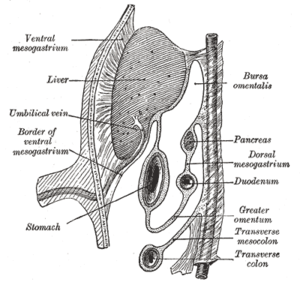Development of mesogastrium
From WikiLectures
- The stomach is connected to the body walls by the ventral and dorsal mesogastrium → thanks to the rotation of the stomach, these hinges also rotate,
- the dorsal mesogastrium is originally located in the middle line of the body; it is pulled to the left → behind the stomach the bursa omentalis (cavum peritonei minus) is formed,
- the ventral mesogastrium is pulled to the right → in the 5th week the base of the spleen from the mesoderm is formed here, which proliferates between the leaves of the dorsal mesogastrium,
- as the stomach rotates, the posterior mesogastrium lengthens and the portion between the spleen and the posterior midline is finally applied to the posterior body wall; there is a connection with the parietal peritoneum,
- the posterior leaf of the mesogastria and peritoneum parietale disappear at the point of contact,
- the spleen remains in the peritoneal cavity.
- spleen ligaments:
- ligamentum lienorenale - connects the spleen to the posterior wall of the body in the area of the left kidney,
- ligamentum gastrolienale - connects the spleen to the stomach,
- spleen ligaments:
- by attaching the posterior mesogastrium to the posterior wall of the body, the final position of the pancreas is given → it is placed retroperitoneally, the cauda pancreatis extends into the dorsal mesogastrium,
- the pancreas is covered by the peritoneum only on its anterior side and becomes a secondary retroperitoneal organ,
- the posterior mesogastrium (stored caudally after rotation) gives rise to a sac-shaped duplication of its bilayer - omentum majus,
- intervenes in front of the colon transversum and the loops of the small intestine,
- later the inner layers of the duplicate merge → a simple double leaf emerges, receding from the curvator major,
- the posterior surface of this double leaf is placed on the hinge of the colon transversum and merges with it and the visceral peritoneum → the gastrocolicum ligament is formed,
- later the inner layers of the duplicate merge → a simple double leaf emerges, receding from the curvator major,
- intervenes in front of the colon transversum and the loops of the small intestine,
- the ventral mesogastrium is a derivative of the mesoderm septum transversum.
- The septum transversum thins with the growth of the liver - it forms the peritoneum of the liver, the ligamentum falciforme hepatis and the omentum minus.
- The margin of the falciform ligament contains the umbilical vein, obliterates after birth to form ligaments. teres hepatis
- The hepatoduodenal ligament (free margin of the omentum minus) contains the portal triad - the choledochus duct, the portal vein and the hepatica propria artery
- It also contains the ventral border of the foramen epiploicum (foramen Winslowi), which connects the bursa omentalis with the rest of the peritoneal cavity.
- The septum transversum thins with the growth of the liver - it forms the peritoneum of the liver, the ligamentum falciforme hepatis and the omentum minus.
References[edit | edit source]
- SADLER, Thomas W.. Langmanova lékařská embryologie. 10. vydání. Praha : Grada Publishing, a.s., 2011. 414 s. s. 237 - 244. ISBN 978-80-247-2640-3.
- MOORE, Keith L a T.V.N PERSAUD. Zrození člověka : Embryologie s klinickým zaměřením. 1. vydání. 2000. 564 s. ISBN 80-85866-94-3.

